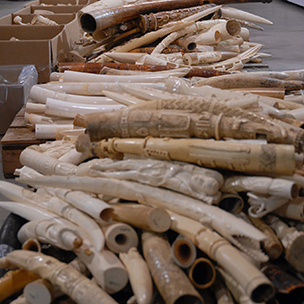June 19, 2015 — This morning the U.S. Fish and Wildlife Service held an “ivory crush” event in Times Square in New York City, highlighting the huge problem that is elephant poaching and wildlife crime more generally. In addition to raising awareness of the problem, the point of pulverizing 1 ton of seized elephant tusks is to diminish demand and disrupt the marketplace for the product. Researchers from the University of Washington believe that slowing demand doesn’t move the needle on this crisis fast enough, though, so they want to use DNA from dead elephants to predict where other elephants may be hunted in the future — and beat the poachers to the spot.
Writing in The Conversation, Samuel Wasser, a research professor of biology at the Center for Conservation Biology at the University of Washington, describes a method his lab has developed to map where past hotspots of elephant poaching have occurred in order to guess where future crime might take place. In a somewhat encouraging conclusion, the researchers found that most of the poaching has come from just two areas in Africa. What this means, Wasser concludes, is that law enforcement efforts focused on just those two hotspots could go a long way in stopping the killing. And if poachers and traffickers just decide to switch their hunting area, Wasser believes his methods, which involve comparing DNA samples from elephant dung in various areas to that of seized ivory to create a reference map, can be applied quickly enough to track the new activity. “Unlike transit countries, source hotspots can’t change very quickly,” he writes. “They require large numbers of elephants and considerable infrastructure to move the ivory out of the country without detection. This infrastructure must also be developed in the next source country before it can become a major hotspot on the scale we have identified. Thus, our methods should be able to detect this.”
Protecting elephants from slaughter would obviously be good news for the species, but, as Wasser explains in the video above, the benefits go beyond, having an impact on everything from the elephants’ ecosystems to international terrorism. ![]()
Photo by USFWS Mountain-Prairie (Flickr | Creative Commons)
Ensia shares solutions-focused stories free of charge through our online magazine and partner media. That means audiences around the world have ready access to stories that can — and do — help them shape a better future. If you value our work, please show your support today.
Yes, I'll support Ensia!
